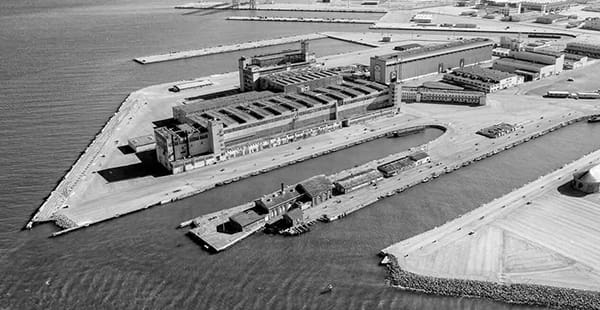01. History
History of Hunters Point Naval Shipyard
The shipyard that became known as Hunters Point opened in 1867 on a southeastern peninsula in San Francisco. It was used as a commercial dry dock facility until 1940. At that point, the U.S. Navy purchased it from Bethlehem Steel Company and repurposed it for the war effort.
From 1945 to 1974, the shipyard primarily acted as a repair and maintenance facility. In 1946, they welcomed ships used in the Operations Crossroads nuclear tests. They studied the ships to develop decontamination procedures. Hunters Point also housed the Naval Radiological Defense Laboratory (NRDL) from 1948 to 1960.
The Navy ceased operations at Hunters Point in 1974. It leased buildings to Triple A Machine Shop Inc. and over 300 artists. In 1986, the Navy reoccupied the property.
In 1989, after an assessment found hazardous chemicals and other materials at the yard, the Environmental Protection Agency (EPA) declared Hunters Point a Superfund site. Asbestos was among the dangerous materials found on site. In 1991, the Department of Defense identified Hunters Point for Base Realignment and Closure.
Today, the environmental cleanup hinders the city’s redevelopment plans for the yard.
Hunters Point Naval Shipyard History at a Glance
- Other Names: HPNS, HPNSY, HPS, Hunters Point Shipyard, The San Francisco Shipyard
- Location: San Francisco, California
- Owner(s): Bethlehem Steel Company; U.S. Navy; Triple A Machine Shop Inc.
- Years of Operation: 1867 – 1986
- Wartime Operations: World War II (WWII), the Korean War, the Vietnam War
- Number of Employees: 18,000 at the end of WWII
- Size of Shipyard: 866 acres (446 underwater)
- Noteworthy Ships: USS Independence (CV-22/CVL-22), USS Blue (DD-744)
- Types of Ships Built/Serviced: Aircraft carriers, battleships, cargo ships, submarines
Workers at Hunters Point Naval Shipyard were potentially exposed to asbestos. Asbestos is a mineral that was common in shipbuilding for most of the 20th century. Asbestos exposure can lead to a number of diseases, like mesothelioma. Workers’ loved ones may have also experienced secondhand exposure.
People who developed an asbestos-related disease may be eligible for compensation.
Notable Ships Built and Repaired
Workers at Hunters Point Naval Shipyard built many ships for wartime efforts. They included battleships, cruisers and others. Ships built at the naval yard had prominent roles in World War II and the Korean War.
At the time these ships were built, asbestos was widely used in building materials. As such, shipyard workers and military personnel faced exposure risks at Hunters Point Naval Shipyard.
USS Independence (CV-22/CVL-22)
The USS Independence joined the Pacific Fleet in 1943. The carrier took part in attacks from Kiribati to the Philippines. Most notably, she helped to defeat the last of the Japanese Mobile Fleet at the Battle of Leyte Gulf.
She was later used as a target during the Operation Crossroads atomic testing. On July 1, 1946, the nuclear explosion took place near the Bikini Atoll, less than half a mile from her. The ship was used in another explosion on July 25 (Test Baker). She was decommissioned in Kwajalein on August 28, 1946.
The radioactive hulk was later taken to Hunters Point for further tests. The then-new NRDL used the USS Independence for training. She was finally sunk in weapons tests off the coast of California on January 26, 1951.
Despite a short lifespan for a carrier, the asbestos used in the materials to build her put many lives at risk. This included the lives of insulators, laggers, electricians, plumbers and pipefitters.
USS Blue (DD-744)
The USS Blue was a destroyer launched in November 1943 in Staten Island, New York. She was very active in WWII as part of the Pacific Fleet in 1944 and 1945. After the war, she spent time in the Puget Sound Naval Shipyard for a complete overhaul in late 1945. In 1946, the USS Blue engaged in anti-submarine warfare exercises and performed patrol duty. She returned to the United States early in 1947 and was placed out of commission in reserve at San Diego.
USS Blue was overhauled at Hunters Point before eventually serving in the Korean War in 1951. She underwent another overhaul at Hunters Point between deployments. After the Korean War, the USS Blue performed tours, local operations and training. She was decommissioned in 1971 and sunk off the California coast in 1977.
USS Blue was active when asbestos use was common at shipyards. This put shipyard workers and crewmembers in danger of developing asbestos-related diseases such as mesothelioma.
Resources for Mesothelioma Patients
02. Asbestos Use
Asbestos at Hunters Point Naval Shipyard
Hunters Point Naval Shipyard operated as part of the Navy from 1941 to 1974. Asbestos was commonly used throughout shipyards at the time. It was often present in boilers, incinerators, insulating materials and other ship elements. This put those in various shipyard occupations at risk of developing asbestos-related diseases.
Asbestos is a durable mineral that is highly resistant to heat. Because it had these properties, shipbuilders often used asbestos during the construction process. Products containing asbestos were fire-resistant and helped control the release of heat. Such products were desirable on ships.
Asbestos Exposure at Hunters Point Naval Shipyard
Members of the U.S. military and civilians provided labor in shipyards and on ships. Asbestos was used in most shipyards and aboard most vessels from the 1930s to 1980s. Those who worked in small and poorly ventilated areas may have been at more risk. Any space where asbestos fibers can linger in the air is more dangerous.
Occupations that risked asbestos exposure at Hunters Point Naval Shipyard include:
- Boilermakers
- Construction workers
- Electricians
- Engine workers
- HVAC workers
- Insulators
- Machinists
- Marine veterans
- Navy veterans
- Pipefitters
- Plumbers
- Ship scalers
- Shipyard workers
- Steamfitters
- Tool keepers
- Welders
Starting in the 1980s, most new manufactured products did not contain asbestos. But anyone who continued working in the shipping industry faced asbestos exposure risks. Exposure could occur through legacy asbestos materials. Shipyard duties like insulating, maintaining boilers and installing pipes, potentially exposed people to asbestos.
03. Lawsuits
Asbestos Lawsuits and Settlements for Hunters Point Naval Shipyard
If you spent time at Hunters Point Naval Shipyard and developed an asbestos disease, you may have compensation options. The companies that manufactured asbestos products that endangered people may be held responsible. The form of compensation may depend on the status of the responsible company.
Mesothelioma lawyers can help victims via:
Some companies that wrongfully exposed workers to asbestos are still viable. In other words, they have not filed for bankruptcy. This means individuals can sue such companies, which may result in a mesothelioma settlement or verdict.
Uniroyal Holding Inc. manufactured asbestos-containing products, including insulation, which were used at shipyards. People who worked with these products were wrongfully exposed to asbestos.
Another viable company is Crown Cork & Seal. They bought Mundet, a firm that made asbestos insulation, in 1963. This insulation was used in shipyards and exposed workers and crews to the risk of diseases like mesothelioma.
Several victims have filed successful lawsuits against these asbestos companies.
04. Trust Fund Claims
Asbestos Trusts Associated With Hunters Point Naval Shipyard
Many companies exposed people to asbestos and have faced associated claims. As a result, more than 60 asbestos companies created trust funds through bankruptcy proceedings. These are established to compensate current and future victims of asbestos diseases.
Many Navy veterans and shipyard workers have developed illnesses after occupational asbestos exposure. For compensation, victims can file an asbestos claim against the responsible asbestos manufacturer’s trust fund.
Asbestos Company Trust Funds and Eligible Years of Employment
The following companies provided asbestos products to Hunters Point Naval Shipyard. After facing many asbestos lawsuits, they filed for bankruptcy and established trust funds. If you worked at Hunters Point Naval Shipyard and developed an asbestos disease, you may be able to file claims against these companies’ trusts.
| Asbestos Trust Funds & Eligible Years of Employment | ||
|---|---|---|
| Asbestos Company Name | Eligibility Start Date | Eligibility End Date |
| Armstrong WI Trust | 1/1/1973 | 12/31/1982 |
| Babcock & Wilcox | 12/31/1982 | |
| Fibreboard | 1/1/1943 | 12/31/1982 |
| Flexitallic | 1/1/1963 | |
| Keene Corp. | 1/1/1943 | 12/31/1982 |
| Narco | 1/1/1963 | 3/31/1964 |
| Owens Corning | 1/1/1944 | 12/31/1982 |
| Pittsburgh Corning | 7/1/1962 | |
| Plant Insulation | 1/1/1936 | 1/4/2000 |
| Western MacArthur | 1/1/1944 | 12/31/1999 |








